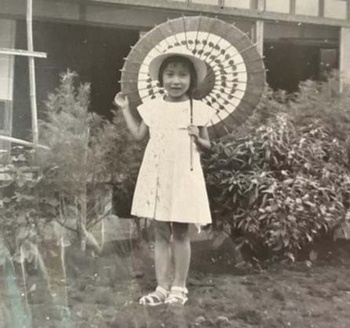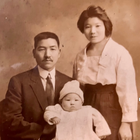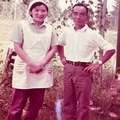Margaret’s Recollections
Despite the tensions with relatives, there were some aspects of the Eto family’s life in Iwasaka and Kumamoto city that were, relatively speaking, better than what was reported by many exiles in postwar Japan. For one, the children, even the older ones, did not experience a serious language barrier and they recall actually finding the local Kumamoto dialect amusing and fun to speak.
Margaret explains:
As for the language barrier, it was minimal since we attended the Vancouver Japanese Language School in pre-war times and we spoke Japanese at home. Sadao had finished grade two and I had finished grade four at Vancouver Japanese Language School, so when our parents enrolled us in the local school, they opted to enroll us (in the grades) where we had left off in 1942. However, the principal (who happened to be our father’s cousin), arranged to pass us into grades four and six respectively, after six months. (Nikkei Images, p. 16)
The eldest son, Tadasu, was quite fluent at Japanese as he had studied Japanese diligently during his incarceration in the POW camp with the help of his former schoolteacher who was also incarcerated there with him. (Nikkei Images, p.16). This enabled him to almost immediately find good employment as an interpreter with the Occupation Forces.
Margaret also points out that, overall, compared to the reported experiences of other exiles, the Eto family experienced relatively less discrimination from adult relatives and village members. She acknowledges the heavy economic burden and stress it must have been for the relatives and the village, which was already crowded at the time with younger generations returning to their parents’ homes.
She notes that, as time passed and both the local economy and the economic situation of the Eto family improved, their relations with their relatives became less strained. She also thinks that the long history of both sides of the family being respected members of the village community was another reason they did not experience the level of discrimination that many other exiles did.
She does recall some bullying from a few of the younger people, partly due to the nice clothes that she and her siblings used to wear. For example, she was sometimes called “Pan-pan” (derogatory term for prostitutes who catered to members of the Occupation Forces) because she wore brighter colors than others, who were wearing school uniforms, and permed her hair.
Naomi explains, “My sisters dressed really nicely—they were beautiful sisters. So, the other students would say ‘Pan-pan kaere! (Go back to your country, prostitute!)” Akemi chuckles, “We didn’t even know what a prostitute was, so we never knew what that meant!” Margaret also remembers her brother John being bullied because of the way he dressed.
When my brother John enrolled in the private school (an all-boys school called Chinzei Koukou), before he could order his uniform he wore a western style suit—our mother had always dressed us so nicely—and he wore that to school at first, and of course they kind of ridiculed him. It was known as a very tough school. He was a shy quiet boy, but he learned to be tough, taking up judo and earning a black belt at an early age.
Margaret also has vivid memories of the physical rigors of village life, especially those due to the lack of plumbing and running water:
Until they put in pipelines years later, we had to go down to the river to get the bathing water. There was a well for drinking water, but for bathing water we had to go all the way down to the river to get it, and I still remember lugging two buckets several times up and down the hill. That was a tough part!That was at least two blocks, and uphill. We had to use a pole with a bucket on each end. My back got strong, so there was some good that came out of it!”
After living in the village of Iwasaka for about four years, Margaret followed her elder siblings and moved to the Kumamoto city, got a job with the occupation forces, and lived with her sisters Mary and Betty. Margaret recalls, “Mary was a great cook and, having cooked for the family during the four years of incarceration and with limited resources, she knew how to make even bologna sound appetizing!” She adds, “I have only memories of eating good food! I was 19. We lived in a dormitory at the base so could use a kitchen to cook.”
Margaret enjoyed the amenities there and came to like life in the city. Akemi adds, “Margaret was lucky (to move to the city) because although we were living in a new house in Iwasaka, it had just a radio, no TV, and no telephone. There was just one place in the village where people had to go if they wanted to use the telephone.”
Akemi’s Recollections
Though being only seven years old when the family arrived in Japan, Akemi has many vivid memories of her life as a child in Iwasaka, both negative and positive. For example, she recalls that many kids, including herself, often suffered from odeki, a kind of boil, so would have to gather a special kind of medicinal herb and put it into their bathwater to cure the boils.
She also recalls having to get various kinds of inoculations “all the time” and having to line up with her grade one classmates and have a white powder (containing DDT) sprayed on their hair to kill lice, even when they did not have lice. The sisters wonder in retrospect how much of the DDT they inhaled although they do not recall any noticeable ill effects.
While she enjoyed school and made many friends, Akemi recalls a few times when she experienced bullying and discrimination from a few of her schoolmates. She explains:
We had to struggle when we were taken back to a place where we didn’t know how to adjust to people. Some Japanese treated us like we were still an enemy. I was only seven years of age, but some kids shouted at me, “Amerika ni kaere! (Go back to America)” …It wasn’t everybody, just one or two students….My 4-years-older brother (John) fought almost every day!!....Of course everyone was still in pain after the war.”
On the other hand, Akemi also has many pleasant memories of her childhood in Iwasaka, for example, enjoying various traditional Japanese customs with her family, such as Otsukimi (moon-viewing).
When the full moon came out, my mom made the fukashi-manju (a kind of traditional Japanese sweet). I used to help her put the sweet potato inside ankou (red bean paste), and then we would go out on the engawa (veranda) and put it there. And there was also Suzuki (a kind of willow) which was put in a vase.
Then some of the neighbors would come and watch the moon and the stars, and I thought that was really nice…Our mother did something like that every month…She celebrated all the special days such as Hina Matsuri (Doll Festival) in March, and Boys Day in May. We would make chimake. Dad would go to the mountains to get bamboo leaves, then steam them, then put the mochi inside and steam them again. Mom always used to do those kinds of things.
The sisters also recall with amusement how the villagers came to call Sunao and Yasue by the names they heard them being called by their children, “Mamma” and “Pappa.” Margaret comments, “When people referred to our parents as ‘Mamma’ and ‘Pappa,’ it was comical to our ears as this is a term that is used for one’s own parents—perhaps these people thought it was our parents’ real names.”
However, the amusement also seems to have worked in both directions with the locals getting some laughs from the sisters’ Japanese Canadian linguistic idiosyncrasies. Margaret recalls one such situation:
When I was taking lessons from a local instructor in kimono-making, I used to have my classmates “in stitches” with my combined jargon of Canadian-Japanese and local Kumamoto dialect. The only thing I can remember from those sessions were the stiff knees that resulted from the sittings.
Another source of both good and bad memories for Akemi was her school life. Her best memories were of her elementary school days in Iwasaka. She recalls, “Our teachers were so nice. They were young and they treated us like younger sisters. I never missed a day going to school. That was the most enjoyable time, for three years!”
However, school life took a turn for the worse when Akemi transferred from public school to a mission junior high school in Kumamoto city. She had been looking forward to attending the local public junior high school (Ozu Chugakko), but the wife of her recently married eldest brother, Tadasu, got her to take a test to go to the private school (Kyushu Joshi Gakuin) and she passed. She explains:
I did not know I was going to go there. It was not my choice, and I had to go into the dormitory because there was no bus from our place, and I had to walk quite aways to take the bus. To get to school it took about two hours, so they put me in the dormitory. That was the first time I had to be away from my family.
They let me go home twice a month. It was so strict, and the dormitory had a strict time schedule. It was a beautiful school, but I was not comfortable going to a place where I didn’t even know anybody. I was the only one to go to a private school as all the other students opted to go to a local school.
The classes were enjoyable but the dormitory life was so strict and we had to adhere to so many rules, I was worried I was being groomed to become a nun. The memorable part for me was at Christmas when we would go caroling. Also, I looked forward to the bi-monthly weekends when I could go home or meet up with my older sisters who would often take me to lunch and movies.
Akemi also has some fond memories of her junior high school days, especially when she used to participate in school plays. One that won their school an award was an English-speaking play in which Akemi played Portia in “Merchant of Venice.”
Naomi’s Recollections
While her older siblings remember their youngest sister as a baby doll, Naomi saw herself growing into a tomboyish girl with her dog always at her side. She fondly remembers roaming the countryside and munching on wildflowers. She remembers her mother as a generous person who always had time and food to offer to strangers, going so far as to have food prepared for a mother, with a little girl in tow, who used to come down from the hills every week.
Naomi also recalls that, following the major flood in the summer of 1951, they opened their home to neighbors who had lost their house during the flood. When her mother saw men working on the roads following the flood, she invited them to sit on the veranda and fed them hot sweet potatoes while Akemi and Naomi served them cold tea or water.
© 2024 Stan Kirk













